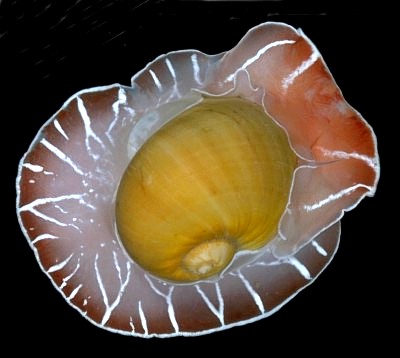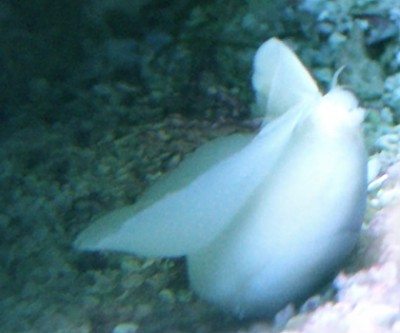

Naticidae - naticids, moon snails
Order: Sorbeoconcha (Neotaenioglossa)
Superfamily: Naticoidea
Family: Naticidae
PHOTO
Two species from Koumac, New Caledonia, October, 1993. Upper: Naticarius orientalis. Lower: unidentified. Photos: Bill Rudman
The naticids are a group of carnivorous marine snails, usually found burrowing in soft sediments. They feed mainly on shelled molluscs, including other snails and bivalves, and are well-known because they use their buccal apparatus and radula to drill a hole through their prey's shell, leaving a very characteristic countersunk drill hole in the shell. In line with their burrowing habit, their body is modified, much as in burrowing shelled opisthobranchs like Philine angasi. The front of the body has a large head shield which partly overlaps the shell, and flaps on either side of the body partially, or in a few species, wholly cover the shell. The shell ranges in shape from a typical spiral snail shell to a very flattened shape, similar to the shell of an abalone (Haliotis spp). A few species, like Sinum spp, can easily be mistaken for a large species of Philine. Many species lay their eggs in a spiral ribbon, embedded with sand grains, forming the characteristic sand collar found on sheltered sand flats in many parts of the world. Most species have a highly polished white shell and a dull white animal, but in a few tropical species, like Natica orientalis illustrated here, the animal can be as brightly coloured as a nudibranch.
Authorship detailsRudman, W.B., 2001 (June 28) Naticidae - naticids, moon snails. [In] Sea Slug Forum. Australian Museum, Sydney. Available from http://www.seaslugforum.net/find/naticid
Related messages
Re: Cephalaspid ? from Lastovo, Croatia
May 20, 2010
From: Thomas Huelsken
Concerning message #23610:
Yes this is Notocochlis dillwynii (Payraudeau, 1826). In the Zootaxa paper you referred to, we discuss the generic classification which is based on the similarity to N. cernica (Jousseaume, 1874) and N. migratoria (=N. gualtieriana (Recluz, 1844)). The latter represents the type species for the genus, erected by Powell in 1933.
Best wishes from Brisbane
Tom
NRW
t.huelsken@gmail.com
Huelsken, T., 2010 (May 20) Re: Cephalaspid ? from Lastovo, Croatia. [Message in] Sea Slug Forum. Australian Museum, Sydney. Available from http://www.seaslugforum.net/find/23666Dear Tom,
Thanks for the confirmation
Best wishes,
Bill Rudman
Re: Cephalaspid ? from Lastovo, Croatia
May 6, 2010
From: Roman Luštrik
Concerning message #23610:
Hi Bill,
Thomas Huelsken has confirmed that this is indeed N. dallwynii. ID solved in half an hour, spanning two continents and three countries. Thumb's up! :) And thanks again.
Cheers,
Roman
roman.lustrik@gmail.com
Luštrik, R., 2010 (May 6) Re: Cephalaspid ? from Lastovo, Croatia. [Message in] Sea Slug Forum. Australian Museum, Sydney. Available from http://www.seaslugforum.net/find/23616Dear Roman,
Glad to be of help. Even if it wasn't a sea slug I have a soft spot for brightly coloured molluscs!
Best wishes,
Bill Rudman
Cephalaspid ? from Lastovo, Croatia
May 5, 2010
From: Roman Luštrik


Can someone ID this one? Photographed during a night dive.
Locality: Lastovo, 20 m, Croatia, Adriatic sea (Mediterranean), 28 April 2010, boulder. Length: 50 mm. Photographer: Marko Gaspari?.
Roman Luštrik
roman.lustrik@gmail.com
Luštirk, R., 2010 (May 5) Cephalaspid ? from Lastovo, Croatia. [Message in] Sea Slug Forum. Australian Museum, Sydney. Available from http://www.seaslugforum.net/find/23610
Dear Roman,
Although its large colourful body certainly suggests this could be a primitive sea slug, your animal is in fact a colourful marine snail of the family Naticidae. I am not an expert on these animals but it looks like it could be
Notocochlis dillwynii. [see http://www.mapress.com/zootaxa/2008/f/zt01770p040.pdf]
Best wishes,
Bill Rudman
Aquarium mystery from South Australia
January 13, 2010
From: Andrea Madeley

Are you able to help me identify this chap?
I have had one in my marine aquarium now for several months. Spends most of the time buried in substrate but every few weeks it surfaces and seems to bask upside down with the big fleshy foot completely expanded, for a day or so and then flips over and goes back into the sand.
It was collected (by mistake) at Goolwa Beach in South Australia when collecting cockles and from what I can gather, these slugs / snails are quite common on this beach.
Locality: Goolwa Beach, on the shoreline, South Australia, 10th December 2009, intertidal. Length: shell 20mm - expanded foot 40 mm. Photographer: Andrea Madeley.
Andrea Madeley
amadeley@activ8.net.au
Madeley, A., 2010 (Jan 13) Aquarium mystery from South Australia. [Message in] Sea Slug Forum. Australian Museum, Sydney. Available from http://www.seaslugforum.net/find/23093
Dear Andrea,
I am pretty sure this is a marine snail which has evolved a somewhat flattened shell which is partially covered by flaps of the body/foot. Quite a few families of snails have burrowing species with similar adaptations. Yours is most likely belongs to the family Naticidae and could possibly be a species of Sinum, but without a good look at the body abnd the shell it is hard to be sure.
Because these animals can be mistaken for slugs, I have a Fact Sheet on the Forum which will give you some background information - and hopefully some clues on where to look for more information. Unfortunately not much research has been done on the Australian naticids but South Australia has an interesting tropical element to its fauna so it is possible this is a tropical Indo-West Pacific species, which might make it easier to name.
Best wishes,
Bill Rudman
Re: Slug-like naticid snail from northern Chile
August 1, 2006
From: Brian Dyer
Concerning message #17125:
Dear Bill:
Thank you for your response regarding the slug-like beast. My background info in mollusks is very superficial, given that I am an ichthyologist without enough natural history fieldwork in the north of Chile. It seems it could be a specimen of Sinum cimba, but will confirm with local malacologists.
Thank you again for putting me on track.
Brian
bdyer@udelmar.cl
Dyer, B.S., 2006 (Aug 1) Re: Slug-like naticid snail from northern Chile. [Message in] Sea Slug Forum. Australian Museum, Sydney. Available from http://www.seaslugforum.net/find/17298Slug-like naticid snail from northern Chile
July 17, 2006
From: Brian Dyer

Attached are photos of a sea slug from northern Chile. I need species Id. if at all possible.
Locality: Bahía Flamenco, north of Caldera, 10-15 m, III region of Atacama, Chile, Southeastern Pacific, 17 June, 2006, subtidal, sandy bottom. Length: 20 cm. Photographer: Marcel Duhart.
Brian Dyer
bdyer@udelmar.cl



Dear Brian,
This certainly qualifies as a sea slug imposter. I am pretty sure this is a snail of the Family Naticidae. They feed on other molluscs, both snails and bivalves, by drilling a hole through their shells. This is probably a species of Sinum, although you would need to consult an expert on the local fauna or an expert on naticids to be sure. In the upper right photo the head is at the bottom of the picture, and there is a 'headshield' with a posterior flap almost covering the somewhat flattened shell. In many ways it mimics a species of the sand-burrowing philinid cephalaspideans such as Philine aperta. The egg ribbon in your photo alongside is a typical egg ribbon of one subgroup of the naticids and is often called a sand collar, because in many species, sand grains are incorporated into the plastic-like ribbon in which the eggs are embedded.
Best wishes,
Bill Rudman
Slug-like snail from Florida
September 5, 2003
From: Paul Osmond


While night diving from shore at one of our favourite macro sites in West Palm Beach, Florida, USA we ran across this little gem.
He was roughly 30mm in size. He was found in about 15 feet of water on the ocean floor under a marina near the shore. As we observed him he started burrowing into the sand, although not to hide - it looked more to be feeding behaviour.
The shell swirl and head shape became obvious once I saw the image on screen, so I believe it could possibly be a Headshield Slug, but not one I could find any record of.
Paul Osmond
marriard@deepseaimages.com
Osmond, P., 2003 (Sep 5) Slug-like snail from Florida. [Message in] Sea Slug Forum. Australian Museum, Sydney. Available from http://www.seaslugforum.net/find/10877Dear Paul,
This is a snail rather than a slug. When we talk of snails and slugs, it can be a bit confusing because in general terms we think of snails as being molluscs with large external shells and slugs as molluscs without shells. But in fact many land slugs and sea slugs have close relatives with large external shells, and many sea snails have close relatives with reduced internal shells.
Your animal is a marine snail of the family Naticidae. I am nnot sure of the species but it is possibly Natica canrena. Members of this family are carnivorous hunters, feeding on other snails and bivalves, often by boring a hole through their shell. The head shield, clearly has the same function as the head shield in the cephalaspidean bubble shells, aiding the animal in burrowing through the sand. However, like the wings of birds, bats and butterflies, the head shields of bubble shells and naticids have evolved independently of each other
Best wishes,
Bill Rudman
Is this a snail or a slug?
July 4, 2001
From: Jim Rigdon

This creature was found in a friend's 180 Reef tank. We are not sure what it is. Can you aid with indentification?
Thanks,
Jim
jim@rigdon.cc
Rigdon, J., 2001 (Jul 4) Is this a snail or a slug?. [Message in] Sea Slug Forum. Australian Museum, Sydney. Available from http://www.seaslugforum.net/find/4701Dear Jim,
This is a Moon Snail (Family: Naticidae). I'm not quite sure why they are called moon snails, perhaps because some have large white shells. Most are white but a few, like yours, have brightly coloured animals. Their main claim to fame is that they feed on other shelled molluscs, both snails and bivalves, by boring a very neat hole through their shells.
Have a look at the top of this page for a bit more information.
Best wishes,
Bill Rudman
